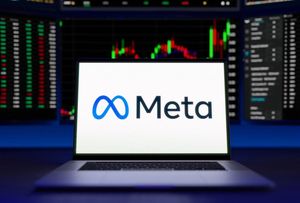
The stage is set, and the curtains are about to rise on the Q3 2025 earnings season, a period historically known to inject both volatility and direction into the financial markets. As investors brace for a deluge of corporate financial reports, the overarching sentiment is one of cautious optimism, albeit with elevated expectations that could lead to significant market movements. This critical juncture will offer a granular look into the health of public companies and, by extension, the broader economic landscape, shaping investment strategies for the coming months.
The upcoming corporate earnings season is poised to be a pivotal determinant of market direction, providing essential insights into the performance of individual companies and the overall economy. This period is characterized by heightened anticipation and increased market volatility as investors meticulously scrutinize financial reports to inform their decisions. Wall Street analysts have, unusually, raised earnings estimates for Q3 2025, projecting an impressive 8.0% year-over-year earnings growth for the S&P 500, marking the ninth consecutive quarter of expansion. This prevailing optimism sets a high bar for companies to meet or exceed, making earnings surprises – whether positive or negative – a significant catalyst for stock price movements.
Detailed Coverage: The Q3 2025 Earnings Landscape Unveiled
The third-quarter earnings season typically commences a few weeks after the fiscal quarter concludes on September 30th, running from mid-October through the end of November. For Q3 2025, the unofficial start saw major U.S. banks like JPMorgan Chase (NYSE: JPM), Citigroup (NYSE: C), and Wells Fargo (NYSE: WFC) among the first to report in mid-October, providing an initial pulse check on corporate health. Johnson & Johnson (NYSE: JNJ) also delivered its Q3 2025 results early in the season. The peak weeks for reports are anticipated between October 27th and November 14th, with November 7th expected to be a particularly active day for announcements.
Several overarching themes are expected to dominate discussions during this earnings season. The "AI arms race" remains a significant narrative, with substantial capital expenditure in artificial intelligence and data center infrastructure. Companies that provide the foundational technologies for this trend, particularly within the technology and semiconductor sectors, are projected to report robust growth. Investors will be keenly assessing whether these AI-related investments are translating into tangible revenue or operational efficiencies. Another critical theme is the divergence in consumer spending, revealing a "have and have-not" economy. Sectors reliant on lower-end consumer spending, such as consumer staples and certain consumer discretionary segments, are bracing for potential earnings declines as shoppers become more value-conscious amidst persistent inflationary pressures. Conversely, higher-end consumer segments may demonstrate greater resilience.
The financial sector is also poised for a strong showing. Major banks like JPMorgan Chase (NYSE: JPM), Bank of America (NYSE: BAC), and Goldman Sachs (NYSE: GS) are expected to benefit from improved banking environments, robust trading activities, and a resurgence in M&A and IPO markets. An acceleration in loan demand could further boost their profitability. While credit quality remains a focus, any signs of increased delinquencies in commercial real estate or among lower-income consumers could introduce caution, but the overall outlook for financials appears positive. Furthermore, companies' ability to sustain profit margins will be critical, given ongoing wage pressures and potential demand softness. Management commentary on Q4 guidance, consumer spending, business investment, and inventory levels will offer crucial insights into the economic momentum heading into 2026, alongside considerations for tariffs and supply chain challenges.
Current market sentiment heading into the Q3 2025 earnings season is largely optimistic. For the first time since late 2021, Wall Street analysts have notably raised their earnings estimates during the quarter rather than lowering them, signaling strong confidence in corporate performance. The S&P 500 is projected to achieve an impressive 8% year-over-year earnings growth, with revenue growth anticipated around 6.3%. Technology and Financials are expected to be standout performers, with the technology sector, particularly the "Magnificent Seven" companies, projected to lead with over 20% earnings growth driven by AI investments and cloud computing. Conversely, sectors like energy (due to volatile oil prices) and consumer staples are predicted to report year-over-year declines. Despite the overall optimism, major U.S. indices are trading at record levels, implying high market valuations and leaving little room for error; any earnings disappointments could lead to swift and punishing responses from investors.
Companies That Might Win or Lose from the Q3 2025 Earnings Season
The upcoming Q3 2025 earnings season is expected to create clear winners and losers across various sectors, driven by prevailing economic trends, technological advancements, and shifting consumer behaviors. The "AI arms race" is undoubtedly a major catalyst, positioning technology and semiconductor companies for significant gains. Firms heavily invested in AI infrastructure, such as NVIDIA (NASDAQ: NVDA), Microsoft (NASDAQ: MSFT), and Alphabet (NASDAQ: GOOGL), are anticipated to report strong growth, benefiting from increased capital expenditure by hyperscalers and enterprises adopting AI solutions. Their ability to demonstrate tangible returns on AI investments and provide robust forward guidance will be crucial for sustaining their elevated valuations. Cloud computing providers will also likely see continued demand, bolstering the performance of companies like Amazon (NASDAQ: AMZN) through its AWS segment.
On the flip side, sectors heavily reliant on the lower-to-middle-income consumer may face headwinds. Companies in consumer staples and certain consumer discretionary categories are expected to report softer earnings as shoppers become more "value-conscious" amidst persistent inflationary pressures. This could impact retailers and brands that cater to this demographic, potentially leading to earnings misses and negative stock reactions. Energy companies, despite recent geopolitical tensions, could also experience year-over-year declines in earnings due to volatile oil prices and potentially lower demand compared to previous periods.
The financial sector, however, is poised for a strong showing. Major banks like JPMorgan Chase (NYSE: JPM), Bank of America (NYSE: BAC), and Goldman Sachs (NYSE: GS) are expected to benefit from improved banking environments, robust trading activities, and a resurgence in M&A and IPO markets. An acceleration in loan demand could further boost their profitability. While credit quality remains a focus, any signs of increased delinquencies in commercial real estate or among lower-income consumers could introduce caution, but the overall outlook for financials appears positive. Companies with significant digital advertising segments, particularly within the "Magnificent Seven," such as Meta Platforms (NASDAQ: META) and Alphabet (NASDAQ: GOOGL), will also be closely watched for trends in ad spending, which can be a barometer for corporate confidence and consumer activity.
Beyond these broad sector trends, specific companies will face unique challenges and opportunities. Tesla (NASDAQ: TSLA), for instance, is expected to report strong Q3 results, partly due to one-off factors like expiring EV tax credits, but will face ongoing scrutiny regarding its growth outlook, intensifying competition in the EV market, and margin pressures. Netflix (NASDAQ: NFLX) will be a key company to watch for its streaming subscriber growth, average revenue per user (ARPU), and the performance of its nascent ad-supported tiers. Any unexpected announcements, such as mergers and acquisitions, changes in management, or significant stock buyback programs, could also dramatically alter the fortunes of individual companies during this high-stakes earnings season, creating both winners and losers irrespective of broader sector trends.
Wider Significance: Beyond the Balance Sheet
The Q3 2025 earnings season is not merely a quarterly financial update; it serves as a critical barometer for broader industry trends and the overall health of the global economy. The pronounced optimism surrounding technology, particularly AI, underscores its transformative impact across industries. The substantial capital expenditures by hyperscalers and enterprises into AI infrastructure signal a long-term shift, indicating that companies are not just experimenting but are deeply integrating AI into their core operations. This trend suggests a potential for significant productivity gains and new revenue streams, but also raises questions about the sustainability of these investments and the eventual return on capital. The performance of key AI players will dictate the pace and direction of technological innovation and adoption across various sectors.
The divergence in consumer spending highlighted in earnings reports is a crucial indicator of economic inequality and inflationary pressures. A "have and have-not" economy could exacerbate social disparities and influence policy decisions related to stimulus, wage growth, and social safety nets. For businesses, this bifurcation means a need for highly targeted strategies, with some thriving in premium markets while others struggle to attract value-conscious consumers. This trend could lead to consolidation in certain consumer-facing sectors as weaker players are acquired or forced out, and it will certainly shape marketing and product development efforts for years to come. Furthermore, persistent inflation, even if moderating, continues to impact purchasing power, forcing consumers to prioritize essential goods and services, which has ripple effects across the entire supply chain.
Regulatory and policy implications are also woven into the fabric of earnings season. As technology giants continue to grow and dominate, increased scrutiny from antitrust regulators and policymakers is inevitable. Discussions around data privacy, market concentration, and the ethical implications of AI could intensify, potentially leading to new regulations that impact business models and profitability. Similarly, the financial sector's performance, particularly regarding credit quality and lending practices, could influence monetary policy decisions by central banks. Any signs of stress in commercial real estate or consumer credit could prompt regulators to tighten lending standards or introduce measures to safeguard financial stability. Geopolitical events, such as trade tariffs or international conflicts, also cast a long shadow, influencing supply chains, commodity prices, and the global operating environment for multinational corporations.
Historically, earnings seasons have often served as inflection points for the market. Periods of sustained earnings growth typically coincide with bull markets, while widespread earnings disappointments can signal economic downturns. For instance, during the dot-com bubble burst, successive quarters of missed earnings by technology companies triggered a significant market correction. Conversely, strong earnings during recovery periods, such as after the 2008 financial crisis, helped to restore investor confidence and fuel market rallies. The current environment, with high valuations and a mix of strong sector performance alongside areas of weakness, bears some resemblance to periods where market selectivity becomes paramount. Investors are looking for companies that can not only meet but exceed expectations, demonstrating resilience and adaptability in a complex economic landscape.
What Comes Next: Navigating the Post-Earnings Landscape
As the Q3 2025 earnings season unfolds, the immediate aftermath will likely be characterized by continued market volatility, driven by individual stock reactions to reported figures and forward guidance. In the short term, investors will be recalibrating their portfolios based on the insights gained, potentially shifting capital towards companies demonstrating robust growth and strong outlooks, particularly within the AI and financial sectors. Companies that miss expectations or provide cautious guidance may experience significant sell-offs, creating both buying opportunities for long-term investors and risks for those without robust risk management strategies. The market's overall direction in the weeks following the peak reporting period will largely depend on the aggregate health of corporate America, as reflected in these reports.
Looking further ahead, the Q3 earnings season will set the stage for strategic pivots and adaptations across industries. Companies that have successfully integrated AI into their operations or product offerings will likely double down on these initiatives, seeking to solidify their competitive advantage. Conversely, those lagging in AI adoption or facing significant margin pressures will need to re-evaluate their strategies, potentially accelerating digital transformations or exploring cost-cutting measures. The divergence in consumer spending will compel businesses to refine their market segmentation and product positioning, with a greater emphasis on value propositions for price-sensitive consumers and premium offerings for the affluent. This could lead to increased M&A activity as stronger companies acquire weaker ones to consolidate market share or gain access to new technologies and customer segments.
Emerging market opportunities will largely center around innovation and efficiency. Companies that can leverage AI to enhance productivity, reduce costs, or create entirely new services will find fertile ground for growth. The continued demand for cloud computing and cybersecurity solutions will also present sustained opportunities. Challenges will include navigating persistent inflation, managing supply chain complexities, and adapting to an evolving regulatory landscape. Geopolitical uncertainties will continue to pose risks, particularly for multinational corporations. Potential scenarios range from a continued bull market fueled by strong tech earnings and economic resilience to a more cautious, sideways market if broader economic concerns or significant earnings disappointments begin to outweigh the positives.
Investors should closely monitor several key indicators in the coming months. Beyond individual company performance, the aggregate earnings growth for the S&P 500 will be a crucial benchmark. Watch for management commentary on Q4 2025 and full-year 2026 guidance, as this forward-looking perspective often has a greater impact on stock prices than past performance. Trends in consumer spending data, inflation reports, and interest rate signals from central banks will also provide critical context for interpreting earnings results and predicting future market movements. Furthermore, keep an eye on any significant shifts in capital expenditure plans, particularly concerning AI and data centers, as these investments will shape the technological and economic landscape for years to come.
Wrap-Up: A Defining Moment for the Market
The Q3 2025 earnings season stands as a defining moment for the financial markets, offering a comprehensive assessment of corporate health and providing critical signals for future economic direction. The key takeaway is a market characterized by high expectations, particularly for the technology and financial sectors, largely fueled by the transformative potential of artificial intelligence and a resurgent capital market. However, this optimism is tempered by underlying concerns regarding consumer spending divergence, margin sustainability, and elevated market valuations, which leave little room for error.
Moving forward, the market will be highly selective. Companies demonstrating strong execution, innovative product development (especially in AI), and prudent financial management are poised to thrive. Conversely, those struggling with declining demand, rising costs, or an inability to adapt to technological shifts will face significant headwinds. The insights gleaned from this earnings season will not only influence stock prices but also guide capital allocation decisions, shape industry competitive landscapes, and potentially impact broader economic policies.
Investors should remain vigilant and discerning in the coming months. Beyond the headline numbers, attention must be paid to management's forward guidance, which often provides the most valuable clues about a company's future trajectory. Monitoring macroeconomic indicators, such as inflation, employment figures, and central bank policies, will be essential for contextualizing corporate performance. The Q3 2025 earnings season reinforces the notion that while past performance is important, the market is ultimately forward-looking, and adaptability, innovation, and strategic foresight will be the hallmarks of success in the evolving financial landscape.
This content is intended for informational purposes only and is not financial advice






